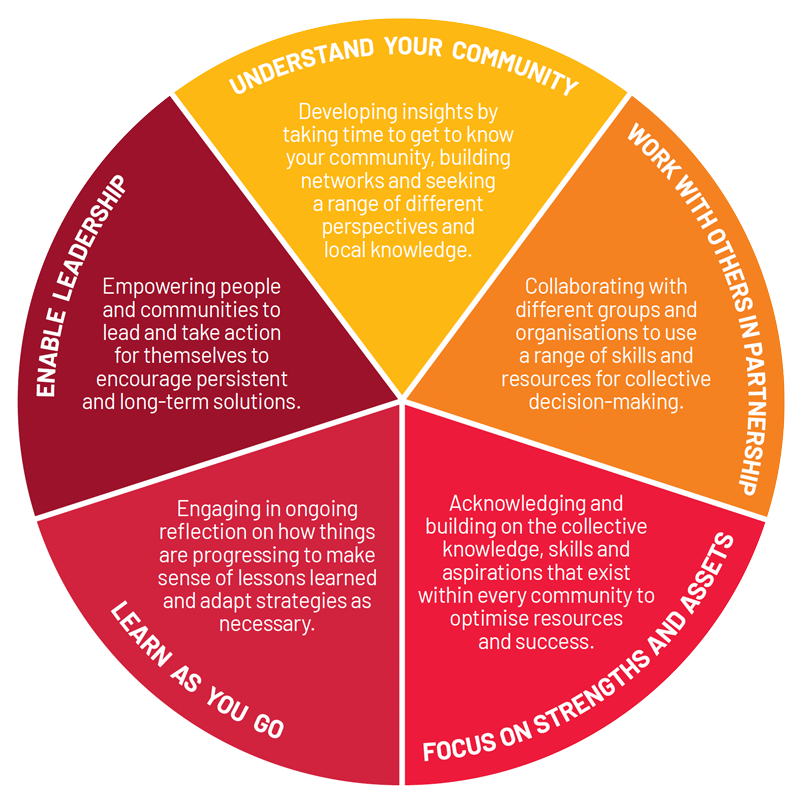Locally Led Approach
Locally Led Approach

What is Locally Led?
The Locally Led Approach is a way of working well with communities, organisations, schools/kura and population groups.
It acknowledges and seeks to learn from what is strong and positive. It’s about working in partnership towards goals, aspirations and opportunities identified by communities, organisations, schools/kura and population groups. By working together, solutions are co-created for positive change.
This adaptive approach draws on lessons from past and current Sport NZ initiatives, including Active Communities Investment projects and He Oranga Poutama, along with other community-led development philosophies.
The Locally Led Approach aims to challenge inequity in the system and work more closely with communities, organisations and groups that face higher barriers to being physically active. An important part of the approach is acknowledging that, as a sector, we do not have all the answers, and it is our responsibility to become partners, enablers and connectors and to identify new ways of working. Communities, organisations and groups face multiple influences and challenges, and many organisations and agencies have their own agendas. To create positive change, we must put the interests, desires and needs of communities first and identify where play, active recreation and sport can play a positive role.
Across the country, many of our partners are taking a Locally Led Approach to working alongside identified communities. They are seeking new partners to improve their understanding of the communities, organisations and groups they are working with. Locally Led is about using more targeted methods and integrating learning as an important part of the process. Once we understand what works, it is critical to effectively share the lessons and how they could benefit other communities, organisations and groups across the country.
Who are our communities?
A community can be a geographical location, such as a suburb or small town, organisation, schools/kura or a population group.
Many people strongly connect to where they live and feel a sense of ownership to their place. It also provides the opportunity to include a variety of people and groups, who will have their own interests and strengths, which creates an opportunity for positive change.
Communities can also be defined as a network or population group through a shared connection such as a culture, whānau, common cause, common barrier, practice or interest.
Communities can therefore be thought of in terms of connected networks or systems where development or change can happen. This means communities of focus (for Locally Led ways of working) can be defined in several ways.
Principles Of The Locally Led Approach
Locally Led principles aim to provide a framework for working well with communities to help them deliver quality play, active recreation and sport experiences.

The principles provide points of reference and critical questions to consider throughout all parts of the process, from planning and resource allocation to partnership and engagement, and implementation and evaluation. By aligning our thinking and actions to these principles, we are committing to a strengths-based approach where:
- decisions are made based on sound knowledge and understanding
- others’ strengths and assets are valued and used for mutual benefit
- shared leadership is an integral and contributing part of positive change in communities.
-
1. Understand Your Community
Developing insights by taking the time to get to know your community, building networks and seeking different perspectives and local knowledge.
One of the best ways to reach and engage a community is to take the time to understand the community and what makes it unique. Talking to people and building relationships will provide different perspectives, knowledge and insights, and enhance local networks. This understanding will help your organisation determine what matters most to local people and where and how you could add value to other projects and initiatives.
The following critical questions will help determine the characteristics of a community:
- What is the history of this community and what is important to it?
- What data, information and local knowledge can we collect and use to understand this community better?
- Which voices in the community do we need to hear from?
- Who are the unusual suspects we could connect with to gain different perspectives?
- What networks, links or systems can we connect with to contribute to our understanding?
- What opportunities are we providing people to add to our understanding?
- What tools do we have and what skills do we need to gain a better understanding of the community?
-
2. Work With Others In Partnership
Collaborating with different groups and organisations to use a range of skills and resources for collective decision-making.
How you work with others will be determined largely by how you view yourselves and others. When you see yourselves as one part of a bigger system with different resources, you can appreciate the role others can play in effecting change. Other organisations hold different sets of resources and strengths, which provides the chance to look for opportunities to work together in partnership. Critical questions might include the following:
- Who are our partners?
- What strengths do our partners have and how can we use them?
- How can we connect to this community and with other agencies?
- What collaboration and relationship tools are available to support this work?
- What role can we play? What role can others play?
- How can we use principles, such as collaboration, co-design and collective action, to create positive change?
-
3. Focus On Strengths And Assets
Acknowledging and building on the collective knowledge, skills and aspirations that exist within every community to optimise resources and success.
This principle is underpinned by the belief that every community has strengths, knowledge, skills and aspirations to contribute. By focusing on what people and communities have and what they are good at, we enable communities to draw on their strengths and assets to achieve their aspirations. A community asset can be a person, the built and natural environment, a community organisation or the history, culture and identity of a place.
Engaging and empowering local communities in this way brings access to more networks, resources and energy, which can lead to more meaningful and persistent change. Critical questions might include the following:
- What are our communities’ strengths, resources and assets?
- What language are we using when speaking with and about our communities - is it positive and enabling or focused on needs and problems?
- Where is this community excelling? What can we learn?
- How can we use this as an opportunity to create positive change?
- What tools, processes and systems can we put in place to enable our organisation to be strengths-based?
-
4. Learn As You Go
Engaging in ongoing reflection on how things are progressing to make sense of lessons learned and adapt strategies as necessary.
It is neither possible nor desirable to know everything before you start a project or initiative, the important thing is a willingness to continue to learn. Constant reflection, learning and adaption are necessary to ensure your strategies are timely, relevant and viable. This requires your organisation to develop open and honest communication with communities to ensure you understand how things are progressing and whether change is required. Critical questions might include the following:
- What are we doing well, how might our role in this need to change? What difference are we making and how, what new possibilities are available to us now?
- What feedback and discussion loops can we build into our practice to ensure the work is dynamic and meaningful?
- What indicators of change, progress, and impact might we look for and why?
- How can we keep our community safe while we trial and test new ideas?
- How can we celebrate and communicate positive changes and learning?
- How can we prepare for failure and moving beyond it? What are the risks? What are the assumptions we are making?
- What systems can we put in place to collect, store and manage information, data and stories to help us understand and change our practice?
-
5. Enable Leadership
Empowering people and communities to lead and take action for themselves to encourage persistent and long-term solutions.
Local leadership is at the heart of the Locally Led Approach, with solutions more likely to be successful and long term where people within communities take action for themselves. This approach recognises and empowers local capacities, strengths, assets and aspirations, and acknowledges that leadership comes in many shapes and forms. Local people with these attributes may not see themselves as leaders in a traditional sense.
Critical questions might include the following:
- How can our organisation understand leadership and grow it within our organisation?
- What is our community passionate about and how can we mobilise that passion in our work?
- What opportunities can we facilitate to enable others to take on leadership roles?
- How can we celebrate and promote the successes of others?
- What tools and systems can we put in place to build our and others’ leadership?
- Consider each opportunity – should we lead from the front, the back, alongside or as part of a group, to foster leadership in others?
Locally Led Approach Maturity Model
Organisations can work out how well they are embedding the Locally Led Approach by working through this interactive planning tool.
The Locally Led Approach is one of the Three Approaches promoted by Sport NZ, with:
The Locally Led Approach
2020 Evaluation Highlights Report
The Locally Led Approach is a way of working with people, groups and communities to understand and acknowledge their strengths, co-create solutions and learn as you go.
This report highlights the value of the Locally Led Approach for Sport NZ, Regional Sports Trusts and groups or communities with low participation in play, active recreation, and sport for the final year of the three-year evaluation period.
